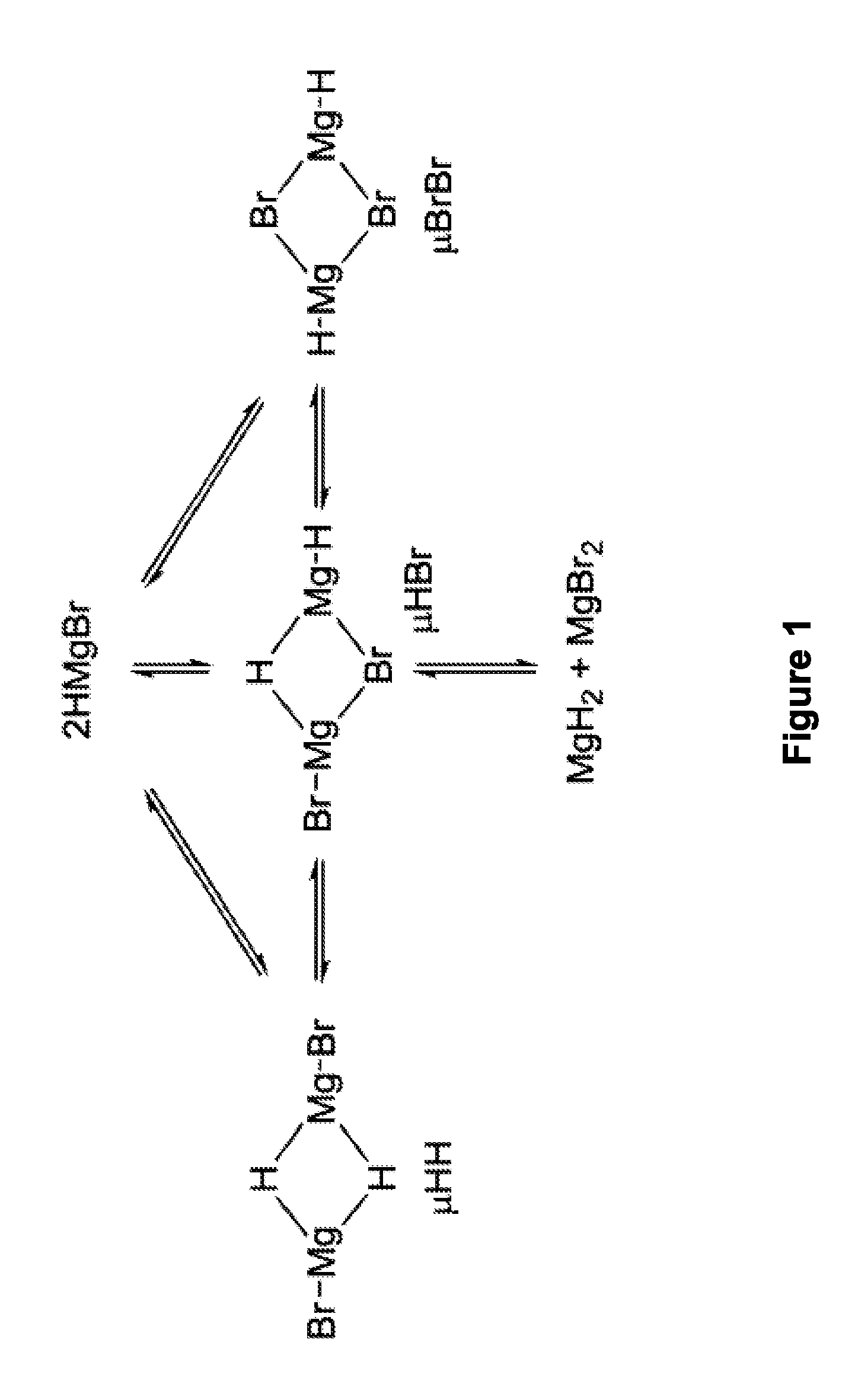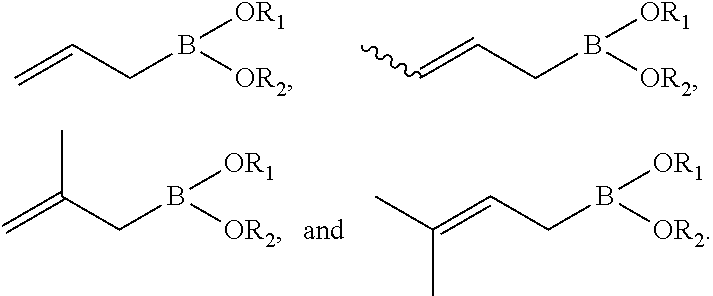Synthesis of boronic esters and boronic acids using grignard reagents
a technology which is applied in the field of synthesis of boronic esters and boronic acids, can solve the problems of catalyst decomposition, high catalyst cost, and invariable requirement of excess boron reagents, and achieve the effects of reducing catalyst cost, catalyst decomposition, and reducing catalyst cos
- Summary
- Abstract
- Description
- Claims
- Application Information
AI Technical Summary
Benefits of technology
Problems solved by technology
Method used
Image
Examples
example 1
Preparation of Aryl and Alkyl-Pinacolboronate Esters Using Preformed Grignard Reagents
[0072]The following procedure for the preparation of m-tolyl pinacolborane is representative. A 25-mL round-bottom flask equipped with a magnetic stir bar and fitted with rubber septum was charged with anhydrous THF (4.0 mL) followed by pinacolborane (0.57 g, 4.5 mmol). m-Tolylmagnesium bromide (4.5 mmol, 1 M / THF) was added dropwise over 5 min. at 25° C. with constant stirring. The reaction was complete after 1 h as evidenced by the disappearance of pinacolborane starting material (δ +27.7, d, J=173.9 Hz), and the appearance of a singlet at +30.5 ppm via 11B-NMR. The reaction was then cooled to 0° C. (ice bath) and acidified with 3 M aqueous HCl (3 mL) (CAUTION: hydrogen evolution). After 10 min of stirring the reaction mixture was warmed to 25° C. and stirred for an additional 30 min. The reaction mixture was then transferred to a separatory funnel and extracted with diethyl ether (3×15 mL). The c...
example 2
Synthesis and Reaction of Neopentylglycolborane with m-Tolylmagnesium Bromide
[0084]A solution of neopentylglycol (17.8 mmol, 1.85 g, 1.2 equiv) in dry THF (10 mL) was stirred and cooled to 0° C. A solution of BH3.SMe2 (15 mmol, 10 M in methyl sulfide) was added dropwise via syringe under argon. After 30 min of stirring at 0° C., the reaction mixture was warmed to 25° C. and stirring was continued until no further evolution of hydrogen was observed (ca. 90 min). The solution was distilled under reduced pressure to isolate pure neopentylglycolborane as a clear oil. m-Tolylmagnesium bromide (10 mmol, 1 M) was added dropwise at 25° C. with constant stirring. The reaction was complete after 1 h as evidenced by the disappearance of neopentylglycolborane starting material (δ +26.9, d, J=176.0 Hz), and the appearance of a singlet at +28.0 ppm via 11B-NMR analysis. The reaction was then cooled to 0° C. (ice bath) and acidified with 3 M aqueous HCl (3 mL) (CAUTION: hydrogen evolution). After ...
example 3
Preparation of Aryl and Alkyl-Pinacolboranate Esters Under Barbier-Type Conditions
[0086]The following procedure for the preparation m-tolyl pinacolborane is representative. A 25-mL round-bottom flask equipped with a magnetic stir bar was charged with magnesium turnings (0.058 g, 2.4 mmol) and was activated by addition of iodine crystals and warming until iodine sublimed. The flask was cooled to 25° C. and was purged with Ar. THF (3.5 mL) was added to the flask, followed by the addition of neat pinacolborane (0.29 mL, 2.0 mmol). m-Tolyl bromide (0.243 mL, 2.0 mmol) was then added drop wise over five minutes with constant stirring at 25° C. The reaction was complete after 3 h as evidenced by the disappearance of pinacolborane starting material (δ +27.7, d, J=173.9 Hz), and the appearance of a singlet at +30.6 ppm via 11B-NMR. The reaction was then cooled to 0° C. (ice bath) and acidified with 3 M aqueous HCl (3 mL) (CAUTION: hydrogen evolution). After 10 min of stirring the reaction m...
PUM
 Login to View More
Login to View More Abstract
Description
Claims
Application Information
 Login to View More
Login to View More - R&D
- Intellectual Property
- Life Sciences
- Materials
- Tech Scout
- Unparalleled Data Quality
- Higher Quality Content
- 60% Fewer Hallucinations
Browse by: Latest US Patents, China's latest patents, Technical Efficacy Thesaurus, Application Domain, Technology Topic, Popular Technical Reports.
© 2025 PatSnap. All rights reserved.Legal|Privacy policy|Modern Slavery Act Transparency Statement|Sitemap|About US| Contact US: help@patsnap.com



